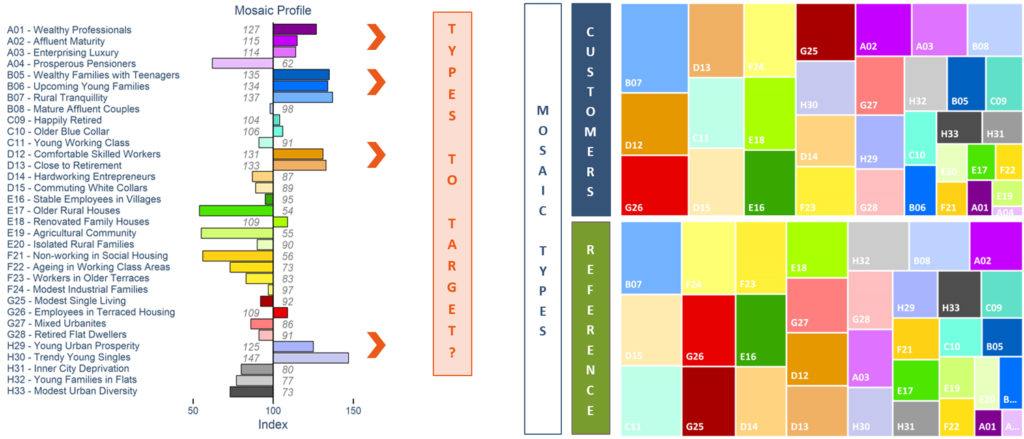
Profiling makes it possible to understand what characterises your customers, the customers for a product, or even your prospects. The value of the process is to improve your offer and communication based on the specific characteristics of your customers. By understanding the characteristics and affinities of your customers, you will know exactly which of them are the most interesting for your business, as well as the arguments that you can put forward to persuade them to buy your products and services.

Understanding the customer is fundamental to the development of any business. Knowing your customers’ needs, motivations, lifestyle, interests and consumption patterns allows you to adapt your offer to their precise needs. The profiling that we offer you at SIRIUS Insight is not limited to the data revealed by loyalty cards, but opens up the scope for action by incorporating numerous socio-demographic and behavioural data present in Mosaic Belgium.
Profiling your customers also helps you to keep your feet on the ground, for example by checking the gap between the target group described in buyer personae and the actual profile of your business’s customers. You will also be able to identify specific customer groups. Study what motivates the most profitable customers, the consumption habits of the customers who buy most frequently, the income classes of customers who buy online, the communication preferences of customers aged 40-45 years, etc.
Creating a profile actually consists of comparing a studied group (customers, prospects, etc.) with a reference group (Belgian households, households of a municipality, households in the catchment area concerned, etc.). This way we distinguish the most significant characteristics of the studied group: Do they come from all over, or from certain neighbourhoods? From certain types of housing? Are they the same age? Do they have the same income? Do they buy the same products?
At SIRIUS Insight, we incorporate the power of Mosaic Belgium into the profiling. Our segmentation of Belgian households categorises the population into 8 groups and 33 types. For each of these types and groups, we have information about family composition, income, type of housing and professional background, as well as a wealth of behavioural data relating to online shopping, mobility, media consulted, leisure activities, etc.

When we profile your customers, we assign a Mosaic type to each customer according to where they live. Your customer base is then compared with the existing Mosaic types (nationally or in the catchment area of a point of sale, for example), allowing the identification of overrepresented Mosaic types within your customer base . This makes it possible to define your target group and take into account all the characteristics that we know about this population. Once this is done, the profile will allow you to search for the prospects who are most similar to your customers.
Profiling will provide you with a great deal of information about your customers: the environment in which they live, their family composition, their income, their preferred communication channels and media, their interest in various topics such as organics, football, mountain holidays, online shopping, etc.
This knowledge will enable you to prime the relevant communication channels for each customer and achieve a very high level of message personalisation.
The use of Mosaic Belgium and the availability of segmentation down to the level of each street segment makes it possible to search for the areas where you will find consumers with a profile similar to that of your customer base. The organisation of door-to-door campaigns, bulk mailings, the opening of pop-up stores or participation in local events in these areas will offer many recruitment opportunities.